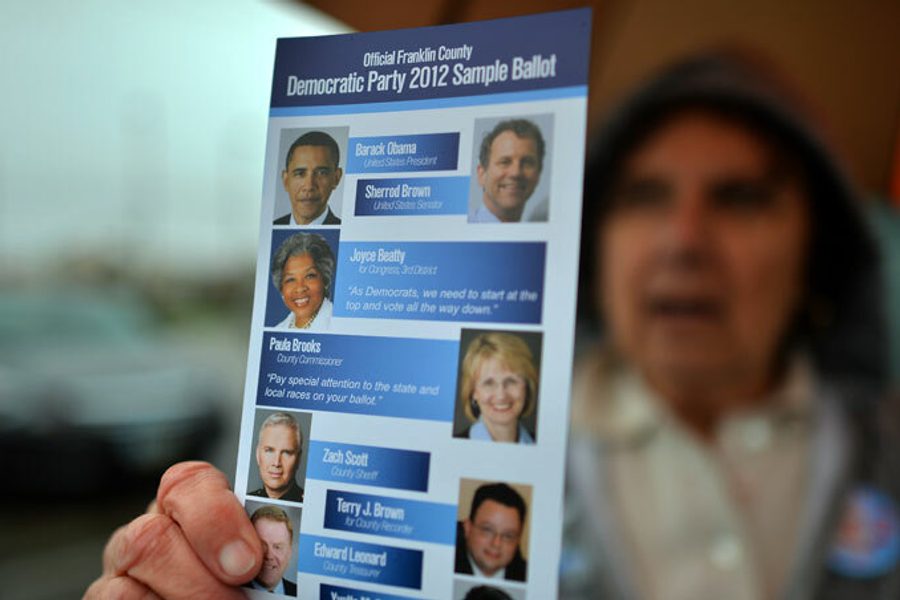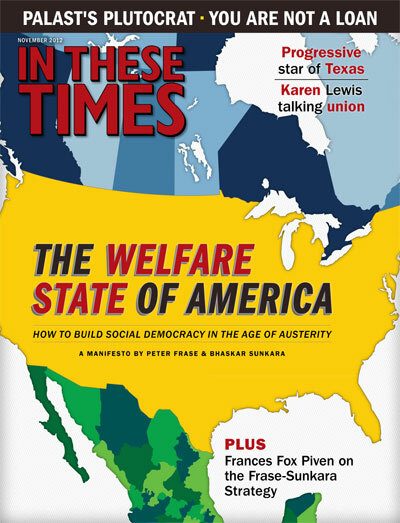
Columbus, Ohio — Theresa Bruskin, a field director for Working America (the AFL-CIO’s community arm), passed a jarring mix of well-maintained bungalows and abandoned homes as she worked her way through Hilltop, a racially diverse, working-class neighborhood. Such traditional “labor to neighbor” campaigns are nothing new. But the walks look different this year: While in the past canvassers visited only union households, this election they’re knocking on every door.
As the unionized share of workers has dropped, the labor movement has tried to retain its political influence by ramping up efforts to contact members, often personally, to urge them to vote.
But that wasn’t good enough. As AFL-CIO President Richard Trumka puts it, labor decided to “push the envelope” in 2012 for what may prove to be a “truly game-changing election.” Reaching out directly to non-union members — a tactic newly allowed by Citizens United—is one element of a broader shift this election season toward increased use of social media and technology, partnerships with non-union groups like MoveOn and longer-term thinking.
The new sophistication was evident in Bruskin’s canvass of Hilltop’s residents. As she listened, Bruskin tapped responses about the candidates and is- sues into her Apple iPod Touch, saving data to guide future canvassers.
“I’m sick of voting for the best of the worst. I’m abstaining,” Joseph Marcum told Bruskin. Marcum, 27, who relies on the Social Security disability benefits he receives for epilepsy, says he would never vote for Romney. “The whole system needs change.” His unemployed friend, Gregory Burns, 29, planned to vote for Obama “to further piss off the scores of 90-year-old white men who don’t want to listen to a black guy” — which he sees as the main reason Congress “does nothing.”
But Rose Toops, 48, a neighbor who does building maintenance work, usually votes for Republicans as the “party of the working class” because “they don’t give away as much” to “moochers.” Still, she complained about how little her mother gets from Social Security (which Romney will not help, Bruskin noted).
Started in 2003 primarily to reach non-union and moderate working-class households in swing states, Working America, the AFL-CIO’s community affiliate, is the prime example of how unions can effectively influence a wider universe of workers. Working America’s 3 million members (one million of whom are in Ohio) are not themselves union members.
The Analyst Institute, a political research group partly funded by the AFL-CIO, found that in last year’s successful campaign to overturn Ohio’s anti-union Senate Bill 5, Working America’s neighborhood canvassing was persuasive. Where someone was home, whether a union member or not, its canvass increased opposition to SB 5 by nearly 15 percent, and even more among conservatives.
The Ohio mobilization over SB 5 also built much-needed bridges between labor and communities, says Ohio AFL-CIO President Tim Burga. “Whether you were in a union or not, you saw organized labor last year as people in the community teaching our kids, keeping them safe, people plowing the snow and picking up trash. This is us.”
By reaching out and organizing working-class communities politically, unions may expand that feeling more broadly among workers that the labor movement “is us” as well. And that’s a political victory that might last many election cycles. Indeed, during Bruskin’s canvass, despite their differing views on the presidential candidates, Marcum, Burns and Toops all responded warmly to Bruskin’s progressive populist message of discouraging offshoring, protecting Medicare and supporting manufacturing.
The labor movement has also ratcheted up its political operations to reach non-union voters. The AFL-CIO, through Workers’ Voice, the federations Super PAC, has formed a new partnership with MoveOn to provide more phone callers and canvassers for labor walks — doubling the number in Ohio after Labor Day. MoveOn Political Director Adam Ruben says the partnership takes advantage of complementary organizational strengths, wedding MoveOn’s virtual infrastructure with Working America’s physical reach. Follow-up phone calls provide immediate feedback on what messages best persuade different voters, enabling the joint canvass to be five times more effective than house calls without feedback, Ruben says.
Meanwhile, a new AFL-CIO online tool allows union members to link up their social media networks with union lists, so their Facebook friends can receive personalized political messages under their names.
Karen Nussbaum, executive director of Working America, says organized labor has to look beyond elections. “The volatile middle — working-class moderates, those most battered by the economy — are the people our movement needs. We make a mistake if we take a utilitarian view of elections. We need a movement to challenge corporate power.”
David Moberg, a former senior editor of In These Times, was on staff with the magazine from when it began publishing in 1976 until his passing in July 2022. Before joining In These Times, he completed his work for a Ph.D. in anthropology at the University of Chicago and worked for Newsweek. He received fellowships from the John D. and Catherine T. MacArthur Foundation and the Nation Institute for research on the new global economy.









